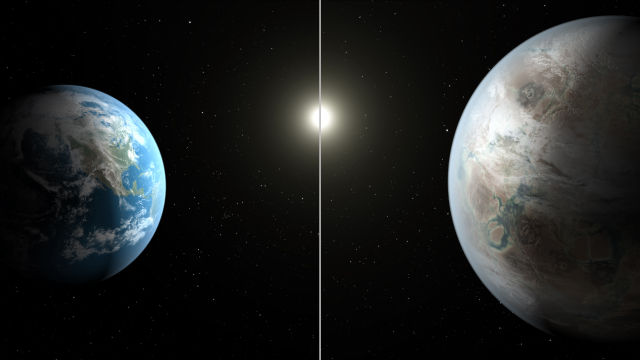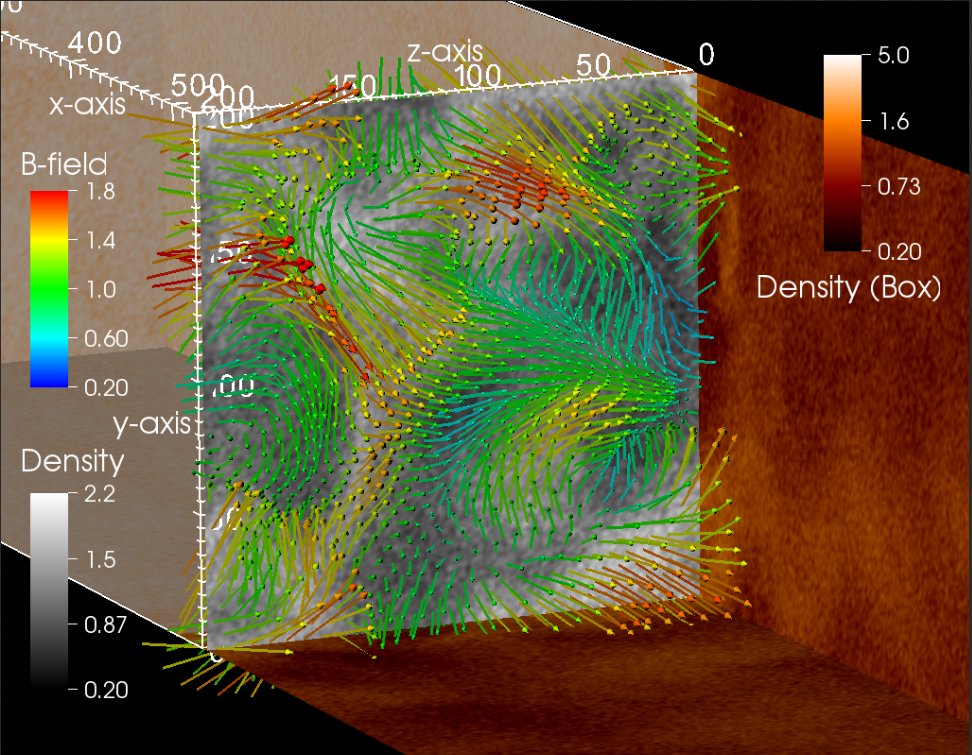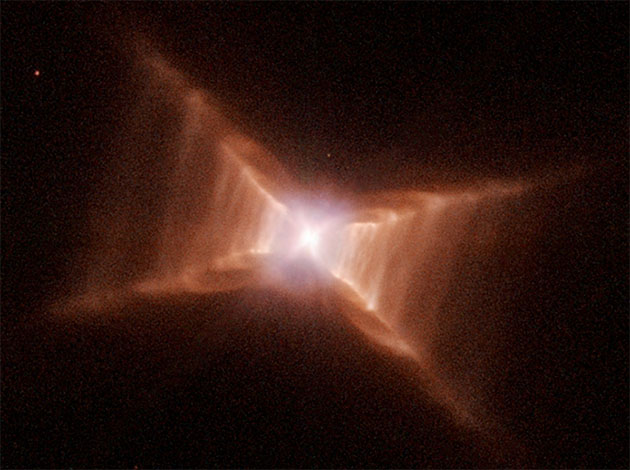 |
 |
 |
 |
 |
 |
 |
 |
 |
 |
 |
 |
|
Talks & Events
|
Faculty Research Seminars: 2018 Quantum Space and Time "Spooky" quantum correlations across large distances have been studied in states of light and matter. The talk will summarize the state of our experiment to study similar macroscopic quantum correlations in states of space and time, originating from new physics at the Planck scale. Journey to the center of the Super-Earth Sub-Neptune, super-Earth size exoplanets are a new planet class. Though absent from the Solar System, they are found by microlensing, radial velocity, and transit surveys to be common around distant stars. In this talk, I'll review both recent developments and outstanding puzzles in our understanding of the nature and origin of these enigmatic planets. Space Probes of the Highest Energy Particles: POEMMA & EUSO-SPB Basic questions regarding ultrahigh energy cosmic rays (UHECRs) remain unanswered:
Giant ground observatories, such as the Pierre Auger Observatory and the Telescope Array, have shown that UHECRs are extragalactic and have a surprising composition trend. Hints of anisotropies begin to appear at energies above ~60 EeV, just when statistics become very limited. We are designing and building space and sub-orbital missions to increase the statistics of UHECR observations at the highest energies. An international collaboration built the Extreme Universe Space Observatory (EUSO) on a super pressure balloon (SPB) to detect UHECR fluorescence from above. EUSO-SPB1 flew in the Spring of 2017. We are now planning EUSO-SPB2 to observe Cherenkov from UHECRs and inform the design of the POEMMA (Probe Of Extreme Multi-Messenger Astrophysics) space mission to discover the sources of UHECRs and observe ~10 PeV neutrinos. Augmented Tensor Virial Equations, Mergers of Galaxies, and the Fate of the Local Group The virial equations and the virial theorem are well known tools of inquiry in dynamical astronomy. However, astronomers seldom appreciate the full power of the tensor virial equations in theoretical investigations of the dynamics of stars and stellar systems. After a brief review of the history of the virial equations and of conventional astronomical applications, we devote most of the seminar to an investigation of the dynamical behavior of a low-dimensional model of a merger of two galaxies. The governing equations of the model are the complete sets of moment equations of the first and second orders derived from the collisionless Boltzmann equations of the galaxies. The moment equations of the first order reduce to an equation governing the relative motion of the galaxies. The moment equations of the second order separate into the tensor virial equations of the galaxies and sets of equations governing the evolution of the kinetic energy tensors of the galaxies. In order to close the systems of moment equations, we represent the galaxies as heterogeneous spheroids with arbitrary stratifications of their density distributions, and we represent the mean motions of the stars in terms of velocity fields that sustain the adopted density distributions consistently with the equation of continuity. We reduce and approximate the governing equations in the case of a head-on encounter of a dwarf galaxy with a giant galaxy. That reduction includes the effect of dynamical friction on the relative motion of the galaxies as in earlier investigations by Tremaine and others. In a survey of mergers involving dwarf galaxies of different masses and sizes, relative to the giant, an encounter either disrupts the dwarf, excites chaotic oscillations in the dwarf, or excites regular oscillations. Dynamical friction can drive a merger to completion within a Hubble time only if the dwarf is sufficiently massive. The survey of mergers provides a basis for an investigation of the evolution and fate of the Local Group. Gigayear instabilities in close-in planetary systems Observing the High-Redshift Universe at Submm Wavelengths The Non-thermal Universe Non-thermal particles and magnetic fields are essential constituents of space and astrophysical plasmas; in the interstellar medium, for instance, they encompass two thirds of the total energy budget. Yet, their complex non-linear interplay makes it difficult to treat them in a self-consistent way, not to mention to couple their dynamics with the larger macroscopical scales of astrophysical interest. I outline how the present generation of supercomputers has opened an unprecedented window in the study of astroplasmas, allowing an ab-initio description of collisionless process such as particle acceleration and generation of magnetic fields, which have direct observational counterparts in the broadband non-thermal emission detected from astrophysical objects and in spacecraft measurements. As an application of such numerical techniques, I show how long-standing questions on particle acceleration at non-relativistic supernova remnant shocks have been finally addressed, and discuss how this can foster our understanding of the supernova feedback in galaxy formation. Clusters of Galaxies as Astrophysical Laboratories Although, clusters of galaxies gravitationally-bound hundreds and thousands of galaxies, their most massive baryonic component is in the form of a very hot gas with the temperature up to a hundred million degrees. Such gas emits in X-rays and is also detected in sub-mm through the Sunyaev-Zel'dovich effect. X-ray, optical and radio observations revealed that the intracluster medium is rich in physics, understanding of which is important for cluster cosmology, galaxy evolution, and physics of plasmas. I will discuss how astronomers use observations and numerical simulations to study the interactions between supermassive black holes and galaxies in the cluster cores, to understand the chemical and thermal evolution of the largest structures in the Universe, to measure microphysical processes such as gas viscosity, conduction, turbulence as well as a wide range of non-thermal processes such as magnetic field amplification and acceleration of cosmic rays. The Dizzying Diversity of Exoplanets The exoplanets discovered to date show a tremendous range of diversity in their masses, sizes, and (inferred) compositions. In this talk, I'll review both recent developments and outstanding puzzles in our understanding of the physics governing planetary interior structure, formation, and evolution. The Diffuse Interstellar Bands (DIBs) In 1919, two fuzzy interstellar absorption "bands" were discovered at Lick Observatory by graduate student Mary Heger. Today, we know of about 600 such features, but they are still unidentified except for a very few suggestions that are not proven (<10). They exist throughout the optical spectral region and there are a few in the IR. I will discuss a large program to study the optical features, to identify them (a far off goal) and to use them to study the interstellar medium. I will discuss the background of past research, correlation studies of DIB to DIB, and two stories of recent progress: the discovery that the fuzziness in some cases arises from IR photon pumping of modest sized molecules and the classification of about 18 of the DIBs that are closely related to the C2 molecule in diffuse interstellar clouds. There are a number of constituents of the interstellar medium whose makeup is not understood: for instance, the numerous types of grains and numerous optical, infrared and microwave radiations, along with the carriers of the DIBs. The DIBs hold out promise of giving us a much better understanding of all these mysterious components and the role they play in the first stages of star formation. CUBS: Cosmic Ultraviolet Baryon Survey The Early Life of George Ellery Hale and the Forgotten Observatories of the University of Chicago George Ellery Hale, the founder of the Department of Astronomy and Astrophysics at the University of Chicago and the Yerkes Observatory Click on the image to enlarge June 29, 2018 was the one-hundred-fifty year anniversary of the birth of George Ellery Hale. Young Hale was a gifted child, who took an early interest in science. His parents, William and Mary Hale, encouraged and supported his scientific interests and activities in generous and remarkable ways. George was a mature student of astronomy and spectroscopy by the time he began undergraduate studies at MIT in 1886. With his invention and initial applications of the spectroheliograph, during his undergraduate years, George Hale established his reputation as a serious astronomer. In 1892, two years after his graduation from MIT, he became a 24-year old Associate Professor of Astronomy at the University of Chicago. In the decade that followed, he founded our Department of Astronomy and Astrophysics, oversaw the construction of the Yerkes Observatory, organized the "World Congress of Astronomy, Astro-Physics, and Mathematics" at the 1893 Columbian Exposition, established the Astrophysical Journal, and played a leading role in the establishment of the American Astronomical Society. Then and subsequently, Hale's vision and activities did much to determine the character and course of American astronomy in the twentieth century. The Dawn of Gravitational-Wave Astronomy We'll provide a brief overview of LIGO's first two observing runs. We will discuss the discovery of GW170817, the first source ever detected in both gravitational-waves and in the electromagnetic spectrum. Among other results, we'll focus on the first standard siren measurement of the Hubble constant, and discuss the near future of gravitational-wave astronomy. |











